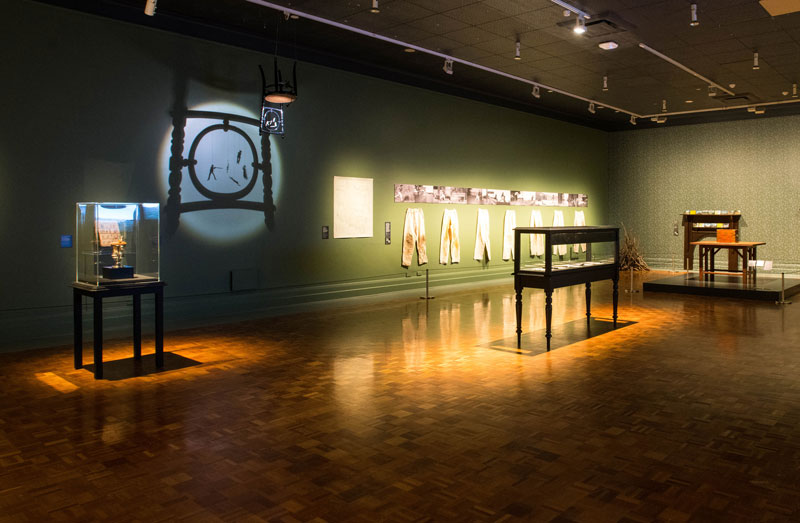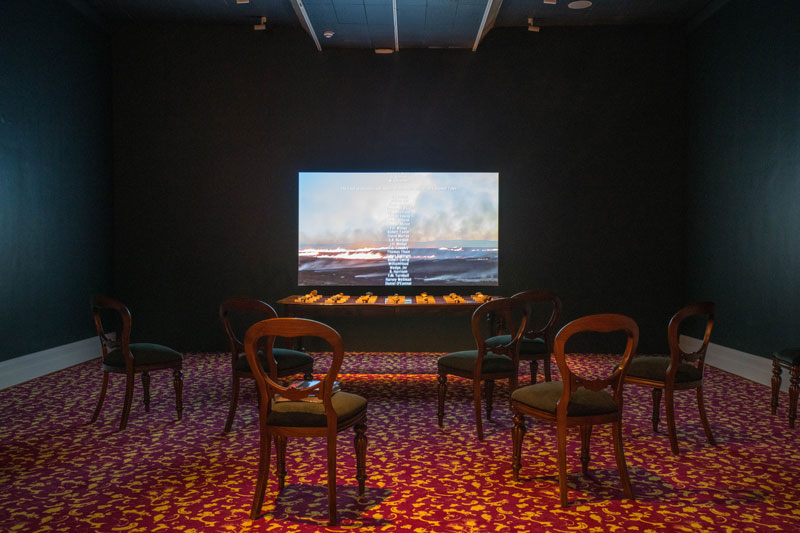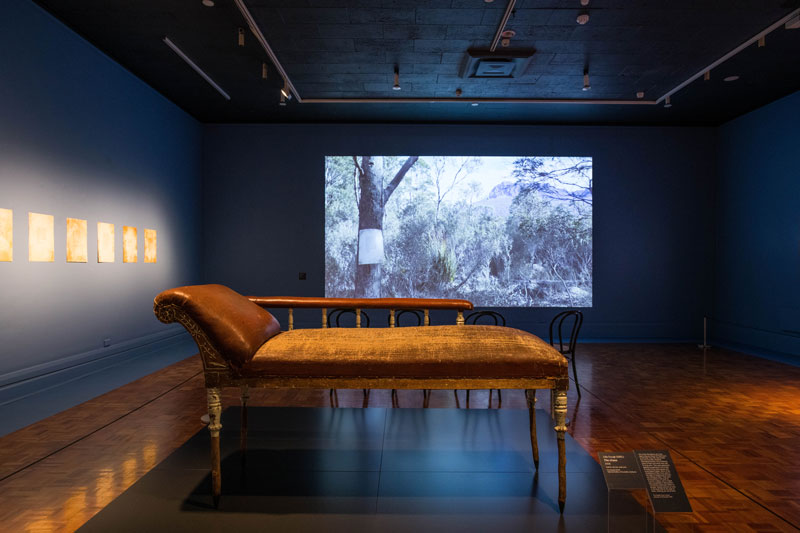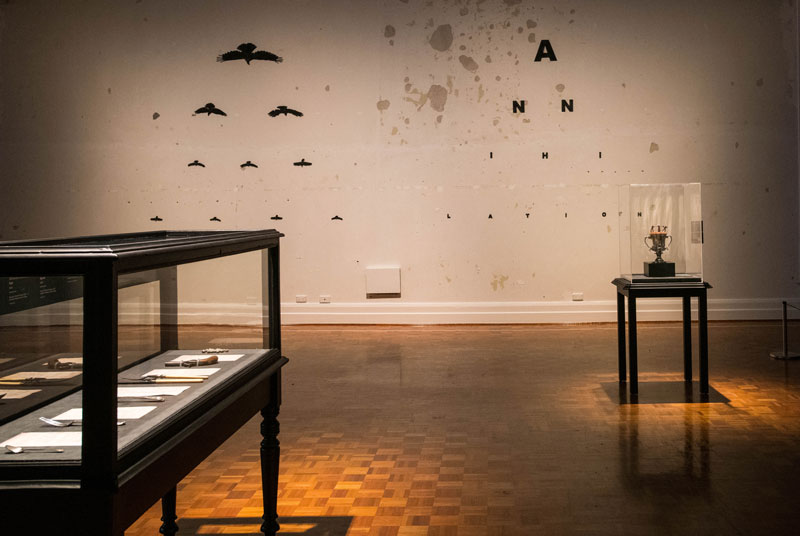
When Europeans invaded Van Diemen’s Land in 1804 they tried to avoid the same mistakes witnessed in Port Jackson, Sydney. Obsessive modern record-keeping, a disciplined marine corps (many newly arrived from the Caribbean), strict surveillance of indentured labour, free settlers and social decorum were all deemed key to creating a simulacra of the English Home Counties. But human nature and, more particularly, the existence of Indigenous peoples challenged this dream of England in the southern hemisphere. Julie Gough’s Tense Past at the Tasmanian Museum and Art Gallery hurtles the viewer into this dangerous and paradoxical landscape.
This is a dark and beautiful, intricate and nuanced exhibition, the culmination of some twenty years of practice. Gough has both white and black ancestors. Her paternal heritage is Scottish and Irish while her matriarchal Aboriginal family line traditionally comes from Tebrikunna, far north-eastern Tasmania, where ancestor Woretemoeteyenner also known as Margaret and Bung, one of the four daughters of east coast leader, Mannalargenna, was born around 1797. Tense Past is about truth telling and a desire to shift the collective amnesia surrounding the compounding aspects of invasion/colonisation on the First Nations that inhabited Van Diemen’s Land/Tasmania.
Hobart boasts Australia’s oldest public space held in the name of the British Crown. The Queens Domain is a wooded ridge that shields the city from the Derwent River. Here Gough made a site-specific public art component for Tense Past. This work, Missing or Dead (2019), was a pathway through the bush. Replicating the manner of colonial proclamations the artist marked 185 trees with sheets of paper that re-presented the unique records of each of the 185 lost and missing Tasmanian Aboriginal children from the period c. 1804 – c. 1850. According to the officially clocked statistics of the Museum of Old and New Art (MONA), this installation was traversed by 70,000 people.
.jpg)
Like most of the works in Tense Past, Missing or Dead derives its authority and clout from the assiduous research of official records, the analysis of power relations, the intersections of personal and public histories – all now time-honoured Feminist post-conceptual methodology. It is strategy that Gough has refined to an extraordinary degree. Working intimately with TMAG Curator Mary Knights these negotiations are the heart and bedrock of Tense Past. What sets this exhibition apart is that Gough understands that objects and records do not speak for themselves by virtue of their survival across time, or the mere fact of their collection and preservation. The very foundation of historical museums serves to underscore the imperialist mindset. In Tense Past Gough is the auteur that re-activates and re-configures a past we thought we knew.
Across five gallery spaces important historical items drawn from diverse Australian institutions are juxtaposed with contemporary works of art, including text-based works, sculpture and video installation that engage with the complex and layered tropes following the arrival of the Europeans to embrace the clash of technologies, the systematic dispossession of land, the destruction of language and culture and of course the genocidal violence of The Black Wars c. 1820–32. There are leitmotifs such as hunting and the hunted; the spear and the gun; the lost and the missing.
A quiet humour underscores the rigour of the art on display. For example, there are titles like Driving Black Home 2 (2009), for a work featuring dash-cam footage of driving through the counties of Van Diemen’s Land past what were once amongst the richest of Indigenous hunting grounds and subsequent killing fields. Subtitles on the bottom of the screen, complementing the inexorable progress of the automobile as well as European settlement, provide a rolling list of land grant recipients as we move through the countryside. For Tasmanians these are familiar names. Complicity in history becomes unavoidable. A discrete text panel beside the video reads:
Land Grants given out between 1804–1832
Van Diemen’s Land 3,125 grants
Acres: 1,842,234 acres
On average one grant given every 3.25 days for 28 years
Tasmanian Aboriginal People in 1804 approx. 5000
Tasmanian Aboriginal People in 1832 approx. 250
The frisson of new knowledges permeates this exhibition. In BAD LANGUAGE v2 (2019) the artist juxtaposes a selection of headline-like communications between Tasmanian Aborigines and Europeans from the 1820s to the early 21st century:
Pooles Marsh VDL “I will put you in the bloody river, ma-am” November 1826
Clyde River VDL “ Parrawar, parraawr, go away you white buggers, what business have you here?’ 21 February 1830
South Esk River VDL “You white bugger, your piece no good” 30 October 1830
The Australian 25 May 2007 ABORIGINES MUST LEARN ENGLISH
The Gathering (2015) is a single-channel video installation that has the air of a colonial dining room or parlour. In the room is an enormous antique mahogany dining table, eight chairs and a rich crimson and gold neo rococo carpet reminiscent of many that once graced the grand estates that dotted the Tasmanian midlands. Gough had asked the guardians of Woolmer’s Estate if she could make a facsimile of one of the wallpapers in the National Trust home. For whatever reason this request was refused so Gough proceeded to create a design for the carpet, with Margaret Woodward, from the exploded Woolmer’s pattern as a macabre echo of the colonial furnishings. Amongst the golden swirls there appear unexpected motifs such as the Scottish thistle, grotesque faces, hip and collar bones as well as silverfish, ironically now the main inhabitants of Woolmer’s.

The Gathering is a haunting work. Haptic details of agricultural life brought into high relief include dead animals, a tuft of fleece on barbed wire, thistles, gorse and blackberries, sentinel-like piles of cleared forest trees and paddock fires. From this melange are unifying images of ceremonial gateway entrances to grand estates. These motifs are overlayed and interspersed with shrill letters and newspaper entries that report the insistent dangers that Aboriginal Peoples represent to the European-style intense farming of the land and the readiness “to subjugate the natives”.
One of the text reports is from the diaries of Protector of the Aborigines, George Augustus Robinson, in which he tells his Aboriginal companions of the government policy of eradication and goes on to report that his companions spent the afternoon weeping. The video concludes with a grass fire at night and a roll call of names of land grantees who signed a letter of thanks to the Governor for his removal of native peoples and proposed conciliation of the Aborigines. The elegiac qualities of the piece are enhanced by the projection above a table with twenty-eight crosses inscribed with the names of large landholdings such as Baskerville Hall, Pansanger, Quamby, Woolmers, Weedington and Killymoon. On the intersection of the crosses are small stones collected from the gateways of each of these properties.
Gough consistently challenges the taxonomical obsessions of traditional museum practice with a range of interventions achieved through the juxtaposition of nature and culture, the old and the new. Dried bracken is stuffed under various pieces of museum furniture. She places humble stones, ceramic and glass shards on top of gridded European maps of country serving to reanimate those authoritative knowledge symbols and tools of control. Bell jars and vitrines, as quasi-scientific objects designed to protect and enhance the status of their contents, are filled with incongruent ephemeral materials from the artist’s own collection. These gestures are powerful statements reiterating the vexed and problematic nature of the archive for Indigenous peoples.
Here, I am reminded of the ultimate indignity in TMAG’s recent history of keeping on public display until 1946 the skeleton of Truganinini as “the last of her people”. Refocussing the lens on these symbols of European eugenics and the colonial power base, some of these vitrines are shrouded to forefront the questionable (often monkey-like) depictions of Tasmanian Indigenous peoples by John Glover or the quasi-fictional Tasmanian landscapes by the convict artist Joseph Lycett, all notably including the salient motif of white men with guns.
.jpg)
Here is also Tasmania’s greatest local craft treasure, the Bothwell Cup (1835), held by the Queen Victoria Museum and Art Gallery, Launceston, presented to George Augustus Robinson in appreciation for establishing a conciliation with the local Aboriginal people. Gough cuts through the empty grandeur and bravura technical skills of the silversmith by making a temporary lid for the cup. Made from clay dug at Bothwell, Impasse: Stolen Ground (2019) employs polychromed cartoon-like figures that reveal the true historical contexts of the cup – Europeans with muskets killing Aboriginal people armed only with wooden spears, including powerless women and children.
Gough has placed nearby a bundle of bark in a domed display vitrine. The combination of objects is a pendent to a jewel-like watercolour by the amateur painter William Knight that depicts a derelict and collapsing structure, what was once a “native hut”. The ruin as fragment, so beloved of the European museum from the 1720s, here becomes a form of documentation of the prior inhabitation and removal of Aboriginal peoples as a signature action of the frontier wars.
Supporting this, Gough places a text from Augustus Robinson’s diary that provides yet more graphic detail: “The natives informed me that the white men about these parts these parts had killed plenty of the natives, that they used to shoot them in their huts in the winter time” (28 October 1830). Here, devastatingly revealed, is the insistent binarism of modernity. In an instant writ large are the tropes of Western civilisation: nature versus culture, the artificial and the real, order and chaos, colonial confidence and self-delusion masking the long-hidden crimes against humanity that we can no longer ignore in the 21st century.

Further capturing this momentum as a sharp rendition of the actions of men is The Chase (2008) from the NGA collection. The title is both a playful riposte to the chaise longue couch as a high-status mainstay of Regency and Victorian parlours. Another context for the making of the work is perhaps the media hysteria around the chance discovery of the Hamilton Couch (c. 1825) one of the earliest pieces of colonial furniture made from red cedar, pearwood and eucalyptus from the hills of Mount Wellington, further examples of which are proudly exhibited upstairs in the Colonial Gallery.
There are also hints of the iconic C.O.Y.O.T.E (1941–48) by Louise Bourgeois (also from the NGA collection). With its frayed, slightly dirty and rudely finished legs as attenuated stakes or spears elevating and animating the form, The Chase was made in response to an incident reported in the Hobart Town Courier, 27 November 1830. In this account two Aborigines staying with George Augustus Robinson in early Hobart Town, on the New Town road, tried to return to Country after discarding their clothes. The full text of the report is writ with steel pins into the frayed leather surface: “they were encountered in the bush by two broom makers, one a cripple who succeeded in taking them. The blacks made every effort to escape. Several persons at work in the bush fled at the sight of them. Nothing can tame them.”
Murder of Crows (2019) is a wall drawing made of letters and the repeated silhouette of the signature bird presented in descending scale like an optical eye-test chart, here stretched across the distressed and scarred surface of the gallery wall. But it takes close reading of the embedded, more-difficult-to-read, lowest letters to comprehend the spelled out word “annihilation”. From other works encountered the viewer already understands that “crows” is a derisive term used to describe Tasmanian Aboriginal people in the early nineteenth century, codified to describe human murder. The authority of the written word to categorise, mark, wound and confound is further captured in works such as Some of Our Women Kidnapped by Sealers (2007) where capital letters run together to read like a chant or lament.

In Observance (2012) the introduced European words are juxtaposed with Aboriginal terms: for example, hilterhanner/gunpowder; perringye/bushranger; hillerpuller/pistol. The latter is a video work that depicts groups of people hiking through Gough’s traditional Country, Tebrikunna in north-east Tasmania. Slowly there is a recognition that the artist is hiding from her ostensible subjects, observing the tourists from a safe distance. Who are these people? What do they want? These glimpses caught through trees and bushes from the cliffs and dunes, mirror the vantage points of Aboriginal peoples encountering the Other for the first time.
More eloquently described by Gough in her recent monograph, Fugitive History: The Art of Julie Gough (UWA, 2018): “Observance is about trespass. The film was made over four years when I camped at Tebrikunna, my maternal Country in north Tasmania. It is a meditation about history, memory and ancestry set amid the ongoing globalisation of my ancestral coastlines. The film is my frustrated response in trying to get back to the essence of things, while being constantly interrupted by groups of intruding eco-tourists. Taking up the region for their continuous walks they remind and re-enact the original invasion of our Country.”
Here again initial humour moves to a deeper understanding to emphasise a primal ugliness in this violation of the peace wrought by the newcomers. Conversely the video Traveller (2013) appears to be a ritual of restitution. The video opens with text from agents of the Van Diemen’s Land Company a commercial venture that cleared the north-east seaboard of the island for sheep farming. The artist dressed in a kangaroo skin cloak and carrying the fine long wooden spears of her ancestors is seen hitchhiking through what today is the richest agricultural land in Australia. She comes across the infamous Highfield House, once the centre of the Van Diemen’s Land Company and finally in a dappled McCubbin-like forest buries a book, the tragic tale of duplicity and destruction by George Augustus Robinson, The Friendly Mission (1829–34). In apt synchronicity, next to the video projection is an antique carrying case filled with spears.
To then encounter Robinson’s original field diaries from the Mitchell Library Collection is extraordinary, shocking and cathartic. The journal is opened at the section where Robinson negotiates with Gough’s ancestor Mannalagenna and “companions” and suggests an equitable almost treaty-like arrangement was made: “I informed him in the presence of Kickerterpoller that I was commissioned by the Governor … they would be allowed to live in their respective districts … and would not allow any bad whiteman to shoot them, and he would go about the bush like myself and they could then hunt. He was much delighted.” (6 August 1831)
As in many of the selected works on display here, and their accompanying texts, the artist demonstrates a nuanced juxtaposition of content and forms, revealing a steely focus and honesty and a gentle if not wry humour. In the past, I have sometimes viewed the work of Julie Gough as over-encoded, too literal for my taste, but on this occasion I was overwhelmed by the presence of such an astute intelligence brought to bear in this composite distillation of twenty years of practice. As to the premise of the work, in the absence of meaningful federal and state government action on Reconciliation and truth telling, Julie Gough: Tense Past is an exemplary exhibition that demands the deployment of the vernacular to quite literally blow your mind or knock your socks off – seeing is believing!
